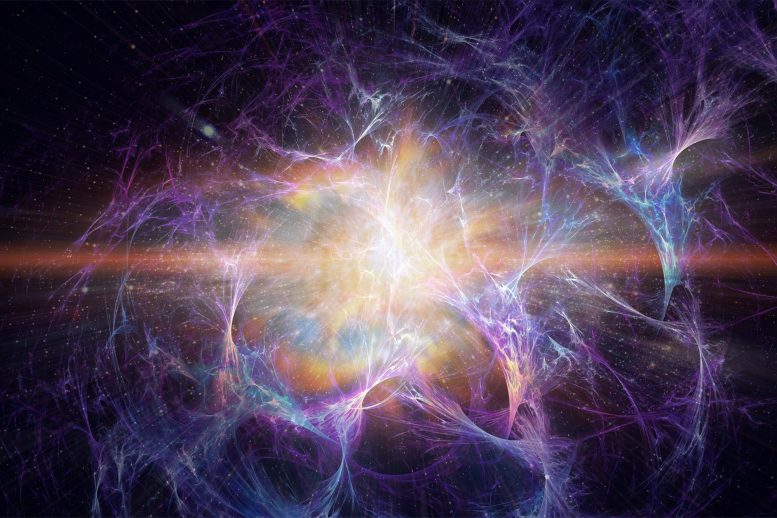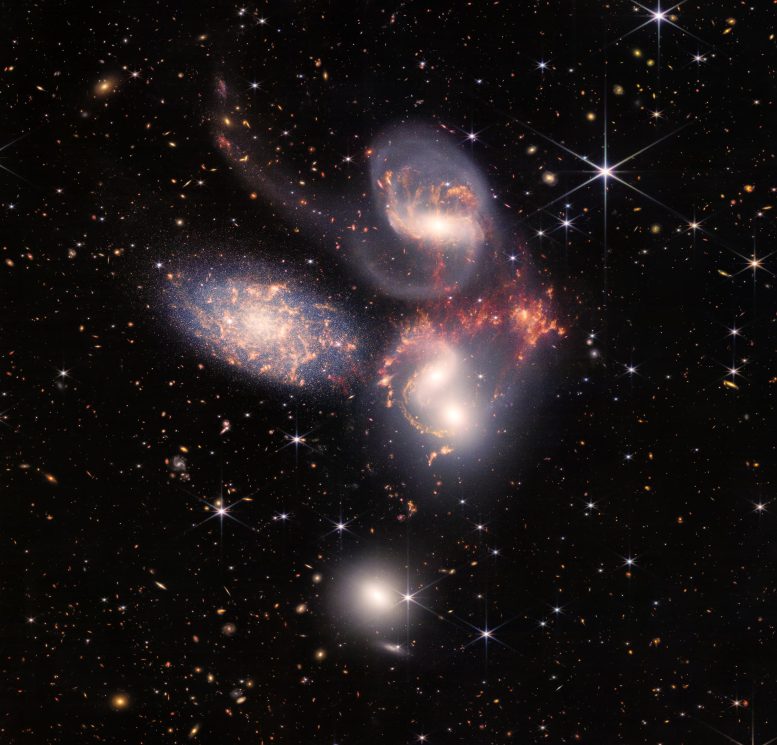
Should theories of cold dark matter hold true, the Webb Space Telescope should discover tiny, bright galaxies of early universe
For the past year and a half, the James Webb Space Telescope has delivered astonishing images of distant galaxies formed not long after the Big Bang, giving scientists their first glimpses of the infant universe. Now, a group of astrophysicists has upped the ante: Find the tiniest, brightest galaxies near the beginning of time itself, or scientists will have to totally rethink their theories about dark matter.
The team, led by UCLA astrophysicists, ran simulations that tracked the formation of small galaxies after the Big Bang and included, for the first time, previously neglected interactions between gas and dark matter. They found that the galaxies created are very tiny, much brighter, and form more quickly than they do in typical simulations that don’t take these interactions into account, instead revealing much fainter galaxies.
The Importance of Dwarf Galaxies in Cosmic Studies
Small galaxies, also called dwarf galaxies, are present throughout the universe, and are often thought to represent the earliest type of galaxy. Small galaxies are thus especially interesting to scientists studying the origins of the universe. But the small galaxies they find don’t always match what they think they should find. Those closest to the Milky Way spin quicker or are not as dense as in simulations, indicating that the models might have omitted something, such as these gas-dark matter interactions.
The new research, published in The Astrophysical Journal Letters, improves the simulations by adding dark matter interactions with gas and finds that these faint galaxies may have been much brighter than expected early in the universe’s history, when they were just beginning to form. The authors suggest scientists should try to find small galaxies that are much brighter than expected using telescopes like the Webb telescope. If they only find faint ones, then some of their ideas about dark matter might be wrong.

The Elusive Nature of Dark Matter
Dark matter is a type of hypothetical matter that does not interact with electromagnetism or light. Thus, it is impossible to observe using optics, electricity, or magnetism. But dark matter does interact with gravity, and its presence has been inferred from the gravitational effects it has on ordinary matter — the stuff that makes up all the observable universe. Even though 84% of the matter in the universe is thought to be made of dark matter, it has never been detected directly.
All galaxies are surrounded by a vast halo of dark matter, and scientists think that dark matter was essential to their formation. The “standard cosmological model” astrophysicists use to understand galaxy formation describes how clumps of dark matter in the very early universe drew in ordinary matter through gravity, causing the formation of stars and creating the galaxies we see today. Because most dark matter particles — called cold dark matter —are thought to move much slower than the speed of light, this process of accumulation would have occurred gradually.
Theoretical Advances in Understanding Galaxy Formation
But over 13 billion years ago, prior to the formation of the first galaxies, ordinary matter, consisting of hydrogen and helium gas from the Big Bang, and dark matter were moving relative to one another. The gas streamed at supersonic velocities past dense thickets of more slowly moving dark matter that should have pulled it in to form galaxies.
“Indeed, in models that do not take streaming into account, this is exactly what happens,” said Claire Williams, a UCLA doctoral student and the paper’s first author. “Gas is attracted to the gravitational pull of dark matter, forms clumps and knots so dense that hydrogen fusion can occur, and thus forms stars like our sun.”
But Williams and co-authors on the Supersonic Project team, a group of astrophysicists from the United States, Italy, and Japan led by UCLA physics and astronomy professor Smadar Naoz, found if they added the streaming effect of different velocities between dark and ordinary matter to the simulations, the gas landed far away from the dark matter and was prevented from forming stars right away. When the accumulated gas fell back into the galaxy millions of years later, a massive burst of star formation occurred all at once. Because these galaxies had many more young, hot, luminous stars than ordinary small galaxies for a time, they shone much brighter.
“While the streaming suppressed star formation in the smallest galaxies, it also boosted star formation in dwarf galaxies, causing them to outshine the non-streaming patches of the universe,” Williams said. “We predict that the Webb telescope will be able to find regions of the universe where galaxies will be brighter, heightened by this velocity. The fact that they should be so bright might make it easier for the telescope to discover these small galaxies, which are typically extremely hard to detect only 375 million years after the Big Bang.”
Because dark matter is impossible to study directly, searching for bright patches of galaxies in the early universe could offer an effective test for theories about dark matter, which has been fruitless so far.
“The discovery of patches of small, bright galaxies in the early universe would confirm that we are on the right track with the cold dark matter model because only the velocity between two kinds of matter can produce the type of galaxy we’re looking for,” said Naoz, the Howard and Astrid Preston Professor of Astrophysics. “If dark matter does not behave like standard cold dark matter and the streaming effect isn’t present, then these bright dwarf galaxies won’t be found and we need to go back to the drawing board.”
Reference: “The Supersonic Project: Lighting Up the Faint End of the JWST UV Luminosity Function” by Claire E. Williams, William Lake, Smadar Naoz, Blakesley Burkhart, Tommaso Treu, Federico Marinacci, Yurina Nakazato, Mark Vogelsberger, Naoki Yoshida, Gen Chiaki, Yeou S. Chiou and Avi Chen, 8 January 2024, The Astrophysical Journal Letters.
DOI: 10.3847/2041-8213/ad1491
The research was supported by the National Science Foundation and NASA.